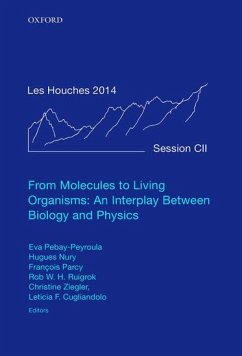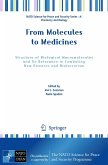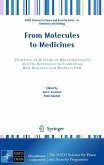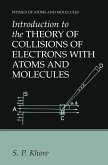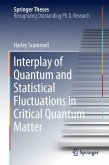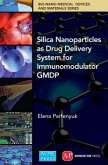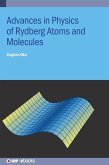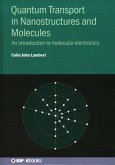From Molecules to Living Organisms: An Interplay Between Biology and Physics
Lecture Notes of the Les Houches School of Physics: Volume 102, July 2014
Herausgeber: Pebay-Peyroula, Eva; Cugliandolo, Leticia F; Ziegler, Christine; Ruigrok, Rob W H; Parcy, Francois; Nury, Hugues
From Molecules to Living Organisms: An Interplay Between Biology and Physics
Lecture Notes of the Les Houches School of Physics: Volume 102, July 2014
Herausgeber: Pebay-Peyroula, Eva; Cugliandolo, Leticia F; Ziegler, Christine; Ruigrok, Rob W H; Parcy, Francois; Nury, Hugues
- Gebundenes Buch
- Merkliste
- Auf die Merkliste
- Bewerten Bewerten
- Teilen
- Produkt teilen
- Produkterinnerung
- Produkterinnerung
The book addresses an emerging field, which aims at bridging several levels of organization in life: from molecules to cells and to organisms. Through examples it presents a new way of thinking using a combination of interdisciplinary and cutting-edge methods, bridging physics and biology beyond current biophysics.
Andere Kunden interessierten sich auch für
![From Molecules to Medicines From Molecules to Medicines]() Joel L. Sussman / Paola Spadon (ed.)From Molecules to Medicines74,99 €
Joel L. Sussman / Paola Spadon (ed.)From Molecules to Medicines74,99 €![From Molecules to Medicines From Molecules to Medicines]() Joel L. Sussman / Paola Spadon (ed.)From Molecules to Medicines79,99 €
Joel L. Sussman / Paola Spadon (ed.)From Molecules to Medicines79,99 €![Introduction to the Theory of Collisions of Electrons with Atoms and Molecules Introduction to the Theory of Collisions of Electrons with Atoms and Molecules]() S. P. KhareIntroduction to the Theory of Collisions of Electrons with Atoms and Molecules59,99 €
S. P. KhareIntroduction to the Theory of Collisions of Electrons with Atoms and Molecules59,99 €![Interplay of Quantum and Statistical Fluctuations in Critical Quantum Matter Interplay of Quantum and Statistical Fluctuations in Critical Quantum Matter]() Harley ScammellInterplay of Quantum and Statistical Fluctuations in Critical Quantum Matter74,99 €
Harley ScammellInterplay of Quantum and Statistical Fluctuations in Critical Quantum Matter74,99 €![Silica Nanoparticles as Drug Delivery System for Immunomodulator Gmdp Silica Nanoparticles as Drug Delivery System for Immunomodulator Gmdp]() E V ParfenyukSilica Nanoparticles as Drug Delivery System for Immunomodulator Gmdp95,99 €
E V ParfenyukSilica Nanoparticles as Drug Delivery System for Immunomodulator Gmdp95,99 €![Advances in Physics of Rydberg Atoms and Molecules Advances in Physics of Rydberg Atoms and Molecules]() Eugene OksAdvances in Physics of Rydberg Atoms and Molecules204,99 €
Eugene OksAdvances in Physics of Rydberg Atoms and Molecules204,99 €![Quantum Transport in Nanostructures and Molecules Quantum Transport in Nanostructures and Molecules]() Colin John LambertQuantum Transport in Nanostructures and Molecules204,99 €
Colin John LambertQuantum Transport in Nanostructures and Molecules204,99 €-
-
-
The book addresses an emerging field, which aims at bridging several levels of organization in life: from molecules to cells and to organisms. Through examples it presents a new way of thinking using a combination of interdisciplinary and cutting-edge methods, bridging physics and biology beyond current biophysics.
Produktdetails
- Produktdetails
- Verlag: Sydney University Press
- Seitenzahl: 432
- Erscheinungstermin: 1. März 2016
- Englisch
- Abmessung: 246mm x 168mm x 28mm
- Gewicht: 1066g
- ISBN-13: 9780198752950
- ISBN-10: 0198752954
- Artikelnr.: 47865285
- Verlag: Sydney University Press
- Seitenzahl: 432
- Erscheinungstermin: 1. März 2016
- Englisch
- Abmessung: 246mm x 168mm x 28mm
- Gewicht: 1066g
- ISBN-13: 9780198752950
- ISBN-10: 0198752954
- Artikelnr.: 47865285
Eva Pebay-Peyroula is Professor at the Grenoble University, France. She received her PhD in Physics in 1986. In the following years, she changed her research interest towards structural biology. During the last 20 years she focuses on membrane proteins, first bacterial rhodopsins and then mitochondrial carriers, and is also interested in the development of novel crystallization methods based on lipidic phases. Hugues Nury is a CNRS researcher interested in structural biology of membrane proteins, and especially of ion channels. He uses biochemistry, biophysics and crystallography to understand the operation mechanism of neurotransmitter-gated ion channels. François Parcy is a CNRS research director. He started as a molecular geneticist of Arabidopsis seed and flower development. In more recent years, he has focused on transcriptional regulations during the development of flowers. He follows an integrative structural biology approach to understand how molecular properties of transcription and chromatin regulators at the atomic scale determine their actions at the genome level. Rob W. H. Ruigrok worked as a group leader with the EMBL in Grenoble for 14 years and became a Professor at the University of Grenoble in 2003. He worked mainly on RNA viruses as influenza, rabies and measles viruses. He uses biochemistry, electron microscopy and crystallography to show how these viruses make new RNA, both mRNA and new viral RNAs, using nucleoproteins and polymerase binding RNA. Christine Ziegler is Professor at the University of Regensburg, Germany. She got a PhD in Radiation Biophysics in 1996. After training as Medical Physicist she moved into the field of structural biology of membrane proteins and worked intensively on the molecular mechanism of secondary transporters. Her main expertise is in 2D and 3D crystallization of membrane transporters and channels as well as in Single Particle Analysis and cryo-electron microscopy. Leticia F. Cugliandolo received her Ph.D. in theoretical physics from the Universidad Nacional de La Plata, Argentina, in 1991. After post-docs in Universita di Roma I, La Sapienza, and CEA/Saclay she joined the Physics Department at Ecole Normale Superieure de Paris in 1997. She is currently a full professor at Universite Pierre et Marie Curie in Paris and the director of Ecole de Physique des Houches since 2007. Her research focuses on statistical physics and condensed matter problems. She received the Marie Curie Excellence Award, the Guggenheim Fellowship and the Prix Langevin of the French Physical Society.
* Part I: Concepts in cell biology and examples of multiscale studies
in biology
* 1: Franz Bruckert: Introduction to cell biology
* 2: Nikolas Herold, Hans-Georg Kräusslich, Barbara Müller: A small
leak will sink a great ship: HIV-host interactions
* 3: Icham Chahtane, Grégoire Denay, Julia Engelhorn, Marie Monniaux,
Edwige Moyroud, Fanny Moreau, Cristel Carles, Gabrielle Tichtinsky,
Chloe Zubieta, François Parcy: Flower development: an integrated view
* Part II: Concepts in Physics and emerging methods
* 4: Guiseppe Zaccai: Thermodynamics (a reminder)
* 5: Enrico Luchinat: NMR spectroscopy, from basic concepts to advanced
methods
* 6: Albert Guskov, Dirk Jan Slotboom: SEC-MALLS to determine protein
oligomeric states
* Part III: Plant development: from genes to growth
* 7: George Coupland: Mechanisms controlling time measurement in plants
and their significance in natural populations
* 8: Oliver Hamant: Forces in plant development
* 9: Christophe Godin: Virtual plants
* Part IV: Forces in Biology: reshaping membranes
* 10: Patricia Bassereau, Winfried Weissenhorn, Michael Kozlov:
Membrane remodeling: theoretical principles, structures of protein
scaffolds and forces involved
* Part V: Conformational changes and their implications in diseases
* 11: Yves Gaudin: Protein conformational changes
* Part VI: Membrane transporters: from structure to function
* 12: Christine Ziegler: The do's and don'ts in handling membrane
proteins for structural studies
* 13: François Dehez: Molecular simulation: a virtual microscope in the
toolbox of integrated structural biology
in biology
* 1: Franz Bruckert: Introduction to cell biology
* 2: Nikolas Herold, Hans-Georg Kräusslich, Barbara Müller: A small
leak will sink a great ship: HIV-host interactions
* 3: Icham Chahtane, Grégoire Denay, Julia Engelhorn, Marie Monniaux,
Edwige Moyroud, Fanny Moreau, Cristel Carles, Gabrielle Tichtinsky,
Chloe Zubieta, François Parcy: Flower development: an integrated view
* Part II: Concepts in Physics and emerging methods
* 4: Guiseppe Zaccai: Thermodynamics (a reminder)
* 5: Enrico Luchinat: NMR spectroscopy, from basic concepts to advanced
methods
* 6: Albert Guskov, Dirk Jan Slotboom: SEC-MALLS to determine protein
oligomeric states
* Part III: Plant development: from genes to growth
* 7: George Coupland: Mechanisms controlling time measurement in plants
and their significance in natural populations
* 8: Oliver Hamant: Forces in plant development
* 9: Christophe Godin: Virtual plants
* Part IV: Forces in Biology: reshaping membranes
* 10: Patricia Bassereau, Winfried Weissenhorn, Michael Kozlov:
Membrane remodeling: theoretical principles, structures of protein
scaffolds and forces involved
* Part V: Conformational changes and their implications in diseases
* 11: Yves Gaudin: Protein conformational changes
* Part VI: Membrane transporters: from structure to function
* 12: Christine Ziegler: The do's and don'ts in handling membrane
proteins for structural studies
* 13: François Dehez: Molecular simulation: a virtual microscope in the
toolbox of integrated structural biology
* Part I: Concepts in cell biology and examples of multiscale studies
in biology
* 1: Franz Bruckert: Introduction to cell biology
* 2: Nikolas Herold, Hans-Georg Kräusslich, Barbara Müller: A small
leak will sink a great ship: HIV-host interactions
* 3: Icham Chahtane, Grégoire Denay, Julia Engelhorn, Marie Monniaux,
Edwige Moyroud, Fanny Moreau, Cristel Carles, Gabrielle Tichtinsky,
Chloe Zubieta, François Parcy: Flower development: an integrated view
* Part II: Concepts in Physics and emerging methods
* 4: Guiseppe Zaccai: Thermodynamics (a reminder)
* 5: Enrico Luchinat: NMR spectroscopy, from basic concepts to advanced
methods
* 6: Albert Guskov, Dirk Jan Slotboom: SEC-MALLS to determine protein
oligomeric states
* Part III: Plant development: from genes to growth
* 7: George Coupland: Mechanisms controlling time measurement in plants
and their significance in natural populations
* 8: Oliver Hamant: Forces in plant development
* 9: Christophe Godin: Virtual plants
* Part IV: Forces in Biology: reshaping membranes
* 10: Patricia Bassereau, Winfried Weissenhorn, Michael Kozlov:
Membrane remodeling: theoretical principles, structures of protein
scaffolds and forces involved
* Part V: Conformational changes and their implications in diseases
* 11: Yves Gaudin: Protein conformational changes
* Part VI: Membrane transporters: from structure to function
* 12: Christine Ziegler: The do's and don'ts in handling membrane
proteins for structural studies
* 13: François Dehez: Molecular simulation: a virtual microscope in the
toolbox of integrated structural biology
in biology
* 1: Franz Bruckert: Introduction to cell biology
* 2: Nikolas Herold, Hans-Georg Kräusslich, Barbara Müller: A small
leak will sink a great ship: HIV-host interactions
* 3: Icham Chahtane, Grégoire Denay, Julia Engelhorn, Marie Monniaux,
Edwige Moyroud, Fanny Moreau, Cristel Carles, Gabrielle Tichtinsky,
Chloe Zubieta, François Parcy: Flower development: an integrated view
* Part II: Concepts in Physics and emerging methods
* 4: Guiseppe Zaccai: Thermodynamics (a reminder)
* 5: Enrico Luchinat: NMR spectroscopy, from basic concepts to advanced
methods
* 6: Albert Guskov, Dirk Jan Slotboom: SEC-MALLS to determine protein
oligomeric states
* Part III: Plant development: from genes to growth
* 7: George Coupland: Mechanisms controlling time measurement in plants
and their significance in natural populations
* 8: Oliver Hamant: Forces in plant development
* 9: Christophe Godin: Virtual plants
* Part IV: Forces in Biology: reshaping membranes
* 10: Patricia Bassereau, Winfried Weissenhorn, Michael Kozlov:
Membrane remodeling: theoretical principles, structures of protein
scaffolds and forces involved
* Part V: Conformational changes and their implications in diseases
* 11: Yves Gaudin: Protein conformational changes
* Part VI: Membrane transporters: from structure to function
* 12: Christine Ziegler: The do's and don'ts in handling membrane
proteins for structural studies
* 13: François Dehez: Molecular simulation: a virtual microscope in the
toolbox of integrated structural biology

